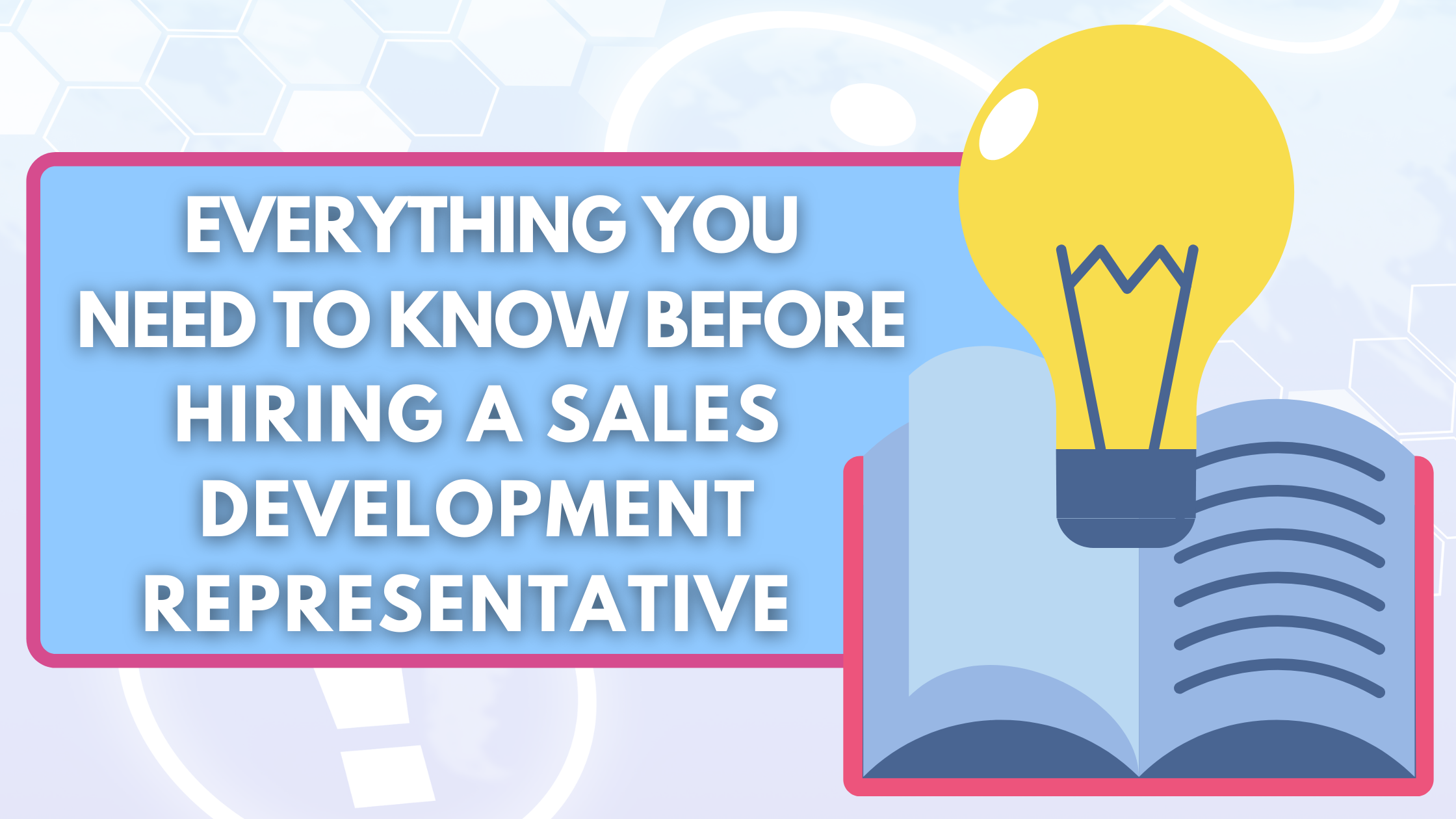What is a Sales Development Representative or SDR?
An SDR is an inside sales representative that focuses on outreach, lead qualification, and prospecting. Historically, these roles were seen as entry-level, or the first step in your sales career. Today, we are seeing major shifts in the perception of SDR’s, as the role becomes more technical and advanced.
To support SDR’s with this change in role and responsibility, online communities and groups are becoming more popular. One of our favorite groups out there – SDR Defenders – is focused on transforming the way organizations think about talent while elevating the role of an SDR.
SDR Defenders says sales development reps often generate around 60% of an organization’s pipeline, yet are the lowest paid. These roles are under constant pressure and are often made to feel as though they could be replaced at any moment.
SDR’s have become a vital component in the B2B landscape. Together, we can change the stigmas around the SDR role and the nature of the position.
What are the Roles and Responsibilities of an SDR?
An SDR focuses on prospecting outbound leads by educating, answering questions, and sending resources to potential customers. They play a key role in qualifying prospects and moving them down the pipeline. Sales Hacker says it best – “Successful SDRs are educators who leverage insights to solve a problem customers are having.”
SDR’s don’t (usually) close deals. Their main goal is to connect with as many leads as possible through:
- Phone calls or Voicemails
- Personalized Videos
- Emails
- LinkedIn connections / Social Media
Job responsibilities on outbound campaigns can include:
- Communicating with prospects and delivering value that meets their pain points
- Monitoring sales intelligence and personalization
- Performing CRM Operations
- Setting Appointments & Managing Calendars
- Reporting & Feedback on Processes or Script Functions
Although more uncommon, some SDR’s may work on Inbound campaigns for their companies. An inbound SDR waits for leads to engage with the company via inbound channels (website, telephone, email, social networks). These roles are focused on scoring and qualifying leads (MQLs) and driving value through incoming messages.
To be successful in these roles, sales development representatives should have:
- Product or service knowledge
- Fluent understanding of their sales tech stack
- Organization and time management
- Resilience and determination
- Conversational skills
Measuring the Success of Your SDR
- Action – Top performers understand they need to be constantly taking action (and that those actions have to be of value.)
- KPI’s & Quality of Activities – Top performers are effective at carrying out the most meaningful activities and getting the most out of their time.
- Consistency- Top performers are consistent with their teams, systems, and processes.
What Separates an Average SDR from the Great?
- Always Be… Learning!
- They learn as much as they can about your target audience. SDR’s should be keeping up with industry standards and reviews of the company. Great SDR’s talk to other sales colleagues, members of their team, and are active in professional development.
- They learn as much as they can about your target audience. SDR’s should be keeping up with industry standards and reviews of the company. Great SDR’s talk to other sales colleagues, members of their team, and are active in professional development.
- Always Be… Paying Attention!
- Great SDR’s take note of the common questions and objections they face in order to be more prepared. They pay attention to traits, pain points, and resources that your best leads have in common and identify areas for improvements.
- Great SDR’s take note of the common questions and objections they face in order to be more prepared. They pay attention to traits, pain points, and resources that your best leads have in common and identify areas for improvements.
- Always Be… Testing!
- Great SDR’s create a repeatable process that works and then constantly refine and test it for improvement. They aren’t afraid to try a new idea they believe in.
Traits and Qualities of a Sales Development Representative
Previously, we’ve talked about the Traits of the Best Cold Caller Ever where Ryan Pereus, Founder and CEO of Superhuman Prospecting, concluded these are some of the most important traits and qualities of an SDR.
They are coachable
All the best athletes have a team around them, coaching them to meet the best of their abilities. Top performers need to be able to take their coaching and apply it to real-world situations.
They role-play/practice every day.
If top athletes practice the process by doing run-throughs and warmups, why not SDRs when they cold call? If you don’t, you are going to be practicing on your prospects, and this is a disservice to them and yourself.
They show up to work each morning with a plan.
Just like Jeb Blount talks about in his book Fanatical Prospecting, platinum hours are those ours reserved for preparing, golden hours are those hours dedicated to execution.
They don’t overthink things.
You can’t execute a conversation by memorizing a script. Using scripts and messaging should guide you, but the execution is about using your intuition, based on what you have learned. Overcomplicating and overthinking won’t help.
They are great at active listening.
This top skill requires picking up on tonality, inflections, and emotions and applying what you’ve learned quickly to ask better questions. Active listening is critical for determining the real root issue the prospect has and thinking about how you can help solve it.
Education
Although a degree is not necessary for the SDR role, some companies prefer to hire those with some form of higher education. A study from Zippia determined that 75.8% of sales development representatives have a bachelor’s degree and 10.1% of sales development representatives have master’s degrees.
And while there are no specific degrees for this role, candidates for SDR positions often benefit from studying business, market research, or marketing. Those who wish to work in more scientific or technical fields may benefit from having more specific, applicable coursework or studies.
Continuing education is important in this field as the industry expands. Companies that provide their SDFR’s with the proper onboarding, training, and education will find more success and have higher tenure of employees.
Pay
According to studies from Zippia and Glassdoor, Sales Development Representatives in America can make an average salary of $44,000-$48,000 per year or somewhere around $21 per hour based on experience. The top 10 percent makes over $64,000 per year, while the bottom 10 percent under $30,000 per year.
SDRs are evaluated on the number of qualified leads they move through the pipeline. Therefore, their commission is determined by the number of deals they pass compared to their target or quota.
Job Outlook
“The U.S. Bureau of Labor Statistics (BLS) indicated that from 2018 to 2028, sales professionals will see a 2% job growth rate. According to PayScale.com, the median income for sales development representatives was $44,299 per year as of 2020.”
An excerpt/chart fromStudy.com
| Educational Requirements | Bachelor’s degree |
| Job Skills | Customer service skills, interpersonal skills, time management skills, analytical skills, mathematical skills, ability to meet deadlines, teamwork skills |
| Median Salary (2020)* | $44,299 |
| Job Outlook (2018-2028)** | 2% (including wholesale and manufacturing sales representatives) |
Other Career Paths:
As the industry and buyer’s journey evolves, so do the positions and titles.
Many leaders are moving towards Business Development Representative or BDR roles for their organization. While some may use these titles interchangeably, Salesforce defines a BDR as focusing on qualifying inbound marketing leads.
There are so many different career options and paths in the sales industry that the SDR can apply their skills. The career experts, Zappia, put together the career map below to show the flow and flexibility of moving up in the sales industry.
Source: Zippia.com 
Account Executive: Account executives are in charge of leading the team in the right direction. Their day to day can include:
- Meetings:
- AE’s spend a good deal of time meeting with their team in order to make sure processes are running smoothly and effectively.
- Conducting Research:
- AE’s need to schedule time in advance to perform market research and find new opportunities and accounts. This can also help with negotiations, which can be a critical part of your success
- Aligning with the Marketing Department:
- A successful AE is constantly looking to generate more leads and develop a better understanding of the different types of leads coming in.
- Average Pay: Base Pay $60,260 / yr
- Lead Account Executive
- $62,483/yr base
- Senior Account Executive
- $64,246/yr base
- Lead Account Executive
Senior Sales Manager:
Senior Sales Executives are normally some of the most experienced members of a sales team.
They are responsible for guiding their team and representatives, ensuring that they are continuously generating leads, managing key accounts, meeting all sales targets, and keeping track of competitors.
- Average Pay: Base Pay $118,255 / yr
- Director of Sales
- $178,632
- Senior Director of Sales
- $180,825
- Director of Sales
Twenty-nine percent of workers cite lack of career opportunity as the key factor that makes them think about leaving their current position. Teams that promote from within their organization boost company morale, save money and increase their retention rate.
Not looking to hire internally? Here are some other options for finding Sales Reps.
In-House vs. Outsourced Sales Development
What is outsourcing? How does an in-house SDR differ from an outsourced SDR?
According to Sales Hacker, sales outsourcing is when a business delegates parts of the sales process to outside individuals or agencies.
For business owners, CEOs, and executives focused on the bottom line, deciding on how to structure their outbound sales program comes down to one thing: cost.
Using the average pay data, we know that the average SDR base salary ranges from $47.8 to $62K. We also know that the average hire comes with less than 12 months of experience and an average tenure of under 16 months.
Not to mention, have you seen the sales tech stack prices lately? Or how about that fancy CRM?
These costs don’t even begin to factor in:
- Software
- Hardware
- Typical overhead costs plus:
- Allocation of human resources
- Costs for hiring, onboarding, training, and retaining employees
According to data from Hubspot, companies are spending around 26% of their time on training, which takes a manager’s time and effort, and automatically reduces the productivity of those around them.
Infrastructure + Hiring (Salary + Commission) +Training (Turnover)+ Overhead Costs
Reporting + Technology + Risk Mitigation + Sales Tech Stack
Scalability + Inside Sales Support + Team Support (Expertise)
= $130,000 (or even more)
Your SDR could end up costing your company more than double their salary. That is a heavy price tag for someone who will probably quit in less than 16 months. And all of this is just for ONE SDR. You may need multiple SDR’s to meet the needs of your business.
If you’re looking to save time, costs, and resources, hiring an outsourced SDR partner could be the right choice for your company.
Studies prove that experienced B2B call centers make a higher volume of calls and get better results than companies performing these tasks themselves.
They create more effective and efficient campaigns with the ability to target better opportunities – like a new audience segment or market altogether. Plus, they have the training, proper tools, and databases needed to make more informed decisions.
They can also expand, scale, or change direction, much easier than in-house teams. Your outsourcing partner knows all the necessary tools like the back of their hand and is automatically leveraging them to produce better results for your company.
When you give your sales teams plenty of time to focus on converting the leads, it substantially increases the conversion rate and shortens the sales cycle. With extra expertise, you don’t give up control, you gain more value.
At Superhuman Prospecting, our cold call, inside sales, appointment setting, and phone marketing lead generation projects all include specific features providing sales consulting, transparency, and results on every campaign.







